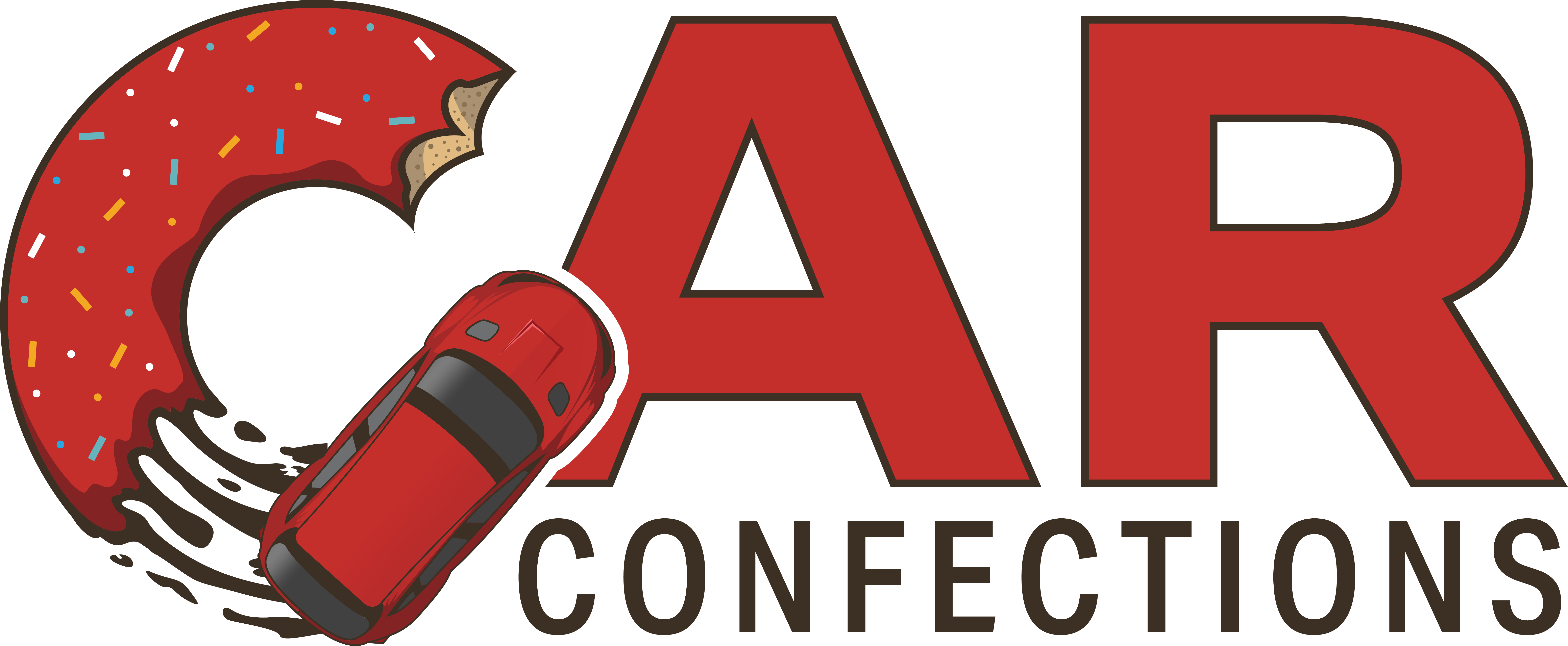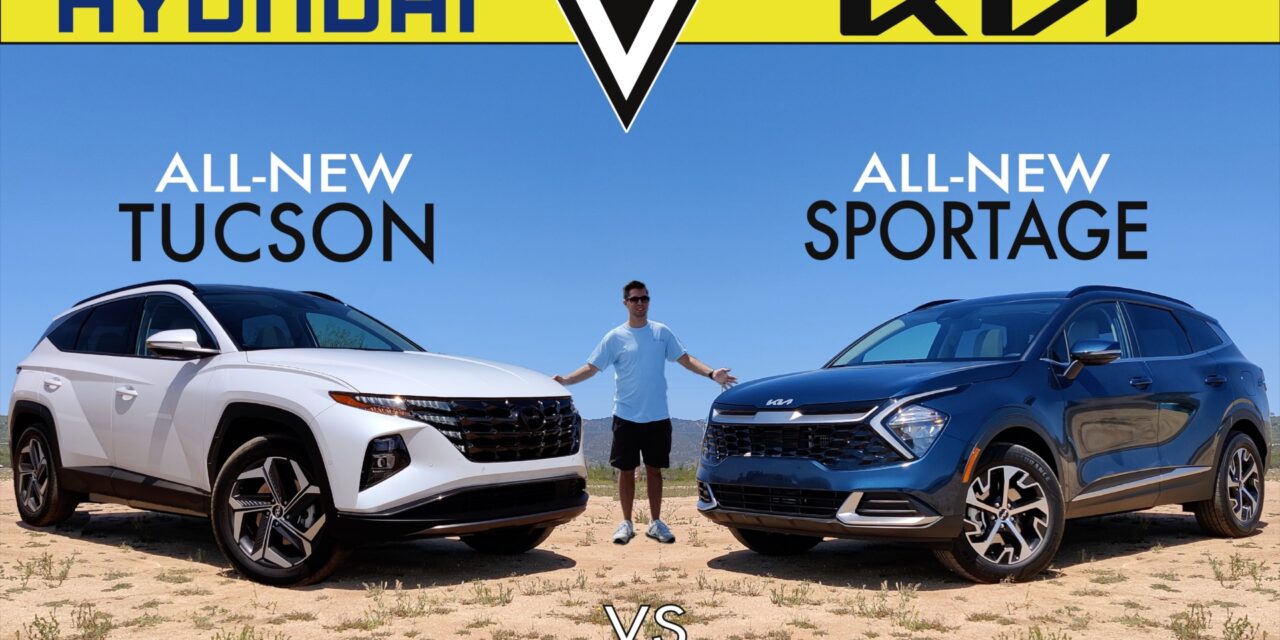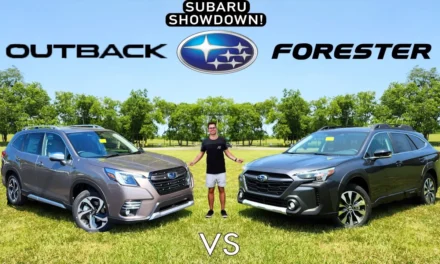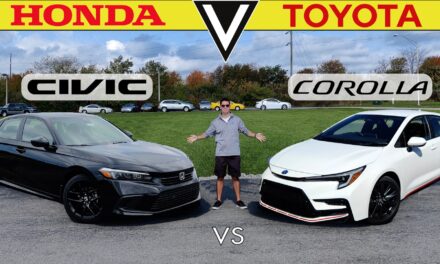.
Introduction
So if you’ve been tuned into auto news recently, you saw that Kia just released an all-new, from-the-ground-up Sportage (hyperlink to Sportage review), including offering a hybrid model for the first time. However, just a few months ago, Hyundai also fully redesigned their Tucson (hyperlink to Tucson review), and now these two Korean siblings are hoping to take a big chunk out of the lucrative compact crossover segment. But just like the comparison between Hyundai Palisade (hyperlink) and Kia Telluride (hyperlink), the question remains, is the one of them a better buy than the other? That’s what we’re about to find out!
Pricing and Equipment
So to get things established here, let’s quickly talk about the pricing and option levels. Both Korean automakers are known for baking in a lot of value and I’m happy to report that this continues for these next generation products.
Starting with the Tucson, we have the fully-loaded Limited Hybrid model, which only has optional floor mats and mandatory $1,245 destination charge. All in, the total price is $39,490.
MSRP (Hybrid Limited AWD): $38,050 | Options: +$195 | Destination: $1,245 | Total: $39,490
Now for the Sportage, we also have the fully-loaded Hybrid model called SX Prestige. After a couple options and the destination charge, the price is about $1,300 less than the Tucson, at $38,155.
MSRP (Hybrid SX Prestige AWD): $36,190 | Options: +$750 | Destination: $1,215 | Total: $38,155
We will revisit that price difference later in the value section, but for now let’s get into the meat and potatoes of this comparison.
Exterior Design and Features
So when it comes to relationship between Hyundai and Kia, their products tend to only share the things that you can’t see, and that is definitely the case with the new Tucson and Sportage. They look nothing alike, but they both have chosen extremely bold designs in their own ways.
The Tucson’s face is almost entirely grille, until you realize that both sides of it are actually a cascading row of daytime running lights when the vehicle is on. The Sportage also has a huge grille dominating the front and a very distinct boomerang-shaped DRL framing it in.
As far as the headlights themselves, both are using projector LED’s, but only the Kia offers LED foglamps.
Continuing our way around to the sides, both have sculpted designs and interesting wheels. The Kia’s are 18-inches and the Hyundai’s are larger 19-inchers.
And out back, the wild design themes continue, especially in the case of the Hyundai which has fang shaped taillights. Both of them have clean rear aesthetics, thanks to wipers hidden under their spoilers, and smooth rear facias that hide the exhaust tips. Interestingly, the Hyundai is the only one that actually has a hybrid badge, as the Kia eschews it in favor of HEV branding.
Towing: Sportage: 2,000 lbs | Tucson: 2,000 lbs
Other Features
Let us know in the comments below which one you prefer more design-wise, but we’re not going to award any points for that because its highly subjective.
But now checking out some of the individual odd and end features, both of their mirrors have heating and blind spot monitoring, [p] and all their other active safety features are also included. Their respective safety suites protect you with full-speed adaptive cruise control, lane keeping assist, forward emergency braking with pedestrian detection, rear auto braking, highway drive assist and auto high beam headlights.
Length: 183.5-inches (Sportage) | 182.3-inches (Tucson)
And the last thing on the outside is warranty information. As you probably know, both brands have the industry leading 5yr/60k mi basic and 10yr/100k mi powertrain warranties, [p] but it’s worth noting that only Hyundai includes 3 years of complimentary maintenance on top of that.
Alrighty, that’s it for the outside, so now let’s see which cabin is best fit for your family!
Interior Design and Features
So walking up the doors, both will come with Smart Entry systems, remote start from the fob, as well as a remote smart parking system for these fully-loaded examples. However, only the Tucson has sensors behind the door handles.
Now opening up the doors, you’ll find two interiors that are just as different as the exteriors, maybe even more so. Before we get into the specifics, I do want to mention the color choices. While the Tucson only offers black or gray options, the Sportage Hybrid has some very expressive colors choices, including a Navy Blue and the Carmine Red you see on this example.
Now as far as the seats themselves, both have 10-ways of adjustment, heating, ventilation and 2-person memory. The Tucson does come with real leather, though.
Once fully inside the cabins, we can check out the broad category of material quality. Both have similar materials, with a mixture of soft and hard touch plastic, piano black trim, [p] and cloth on Hyundai, faux aluminum on the Kia.
After startup, you’ll see full digital gauge arrangements. The graphics are similar between them and both have blind spot camera monitoring systems, but as you can probably tell, the Sportage’s is larger at 12.3-inches vs. 10.25-in.
Coming back to the steering wheels, both are leather-wrapped, with heating, and they have rain sensing wipers.
But moving on to one of our other most important elements, let’s discuss the storage. Under the center consoles and in the front storage bins, they are roughly equivalent to each other, however, the Kia’s dual-purpose bin is impressive. It can be used as traditional cupholders or they can be folded away to store large objects or hold larger bottles.
Both have wireless phone charging pads.
Heading next to the shifters, they have two different varieties of electronic ones. Both are pretty easy to get used to, and when in reverse, both have 360-degree backup cameras. That being said, Sportage has an extra trick up its sleeve since it has a 3D view which is something usually reserved for luxury vehicles.
Now moving up the dashboards, neither of these two choose a traditional dual-zone climate control setup. The Tucson went for entirely touch capacitive buttons, and Sportage did as well except for two knobs that are both temperature controls and audio controls when you change the mode. In practice, both work pretty well after you take a sec to familiarize yourself.
As far as the audio systems, we have 8-speaker branded sound systems on deck for both crossovers.
Tucson: 8-speaker Bose Premium audio
Sportage: 8-speaker Harmon Kardon Premium audio
One area that is 90% the same are the infotainment systems. The software, navigation maps and processing is all the same besides for graphics. They both also have wired Android Auto and Apple CarPlay, but the main difference is that, once again, the Sportage has a 12.3-inch display instead of a 10.25-in one.
Moving up from there, the Tucson has an auto-dimming mirror with Homelink remotes and both of them have large panoramic moonroof’s.
Rear Seats and Cargo
Now as we head into the rear areas, you’ll see impressive improvements over both of their last gen versions, since they went from some of the smallest offerings in the segment, to some of the largest. The over 6-inches of extra length translates to an enormous 41.3-inches of rear legroom and over 39 inches of headroom.
Tucson: 41.3 inches of legroom | 39.5 inches of headroom
Sportage: 41.3 inches for legs and 39.1 inches for heads
In addition to large accommodations we have some nice amenities on board as well. Both have vents and 2 USB ports, although only the Hyundai includes heated rear seats. HALF
Moving out back, both have power tailgates with hands-free smart opening.
And once inside, just like the back seats, you’ll see some of the largest cargo capacities in the class. While there are obviously some small differences in measurements between them, they are essentially equal to each other.
Tucson: Behind 2nd row: 38.7-cu.ft | Max: 74.5-cu.ft
Sportage: Behind 2nd row: 39.5 cubic feet | 73.7 cu.ft with the seats folded
Note: both have spare tires
Alright, this comparison is not over yet, so now let’s take them out on the road and see how they stack up.
Test Drive and Fuel Economy
So far through this video, there have been far more differences than similarities, [p] but in these areas you can’t see, they share a lot more. Included in that is the entire hybrid powertrain, both using 1.6L turbo 4-cylinders, paired to an electric motor and lithium ion battery pack. Together, they produce total system output of 227 hp, which is approximately 40 more horsepower than each of their respective regular gas models.
Tucson Hybrid: 1.6L Turbo I-4 + Electric: 226 hp | 258 lb.ft
Sportage Hybrid: 1.6L Turbo I-4 + Electric: 227 hp | 258 lb.ft
One of the other interesting things about this shared powertrain is that the hybrid system is paired to a traditional 6-speed automatic transmission. Almost all other hybrid vehicles on the market use CVT’s instead, so this gives you a quote-on-quote more normal feel that most people appreciate.
Now as far as other driving characteristics, both have nice ride quality and pretty well controlled dynamics. Of course, neither of them are going to feel sporty, but they can hold their own when tossed around some corners, and sport mode livens up the powertrain quite nicely.
Of course, one of the signature things we like to do on this channel is compare the sound levels of the vehicles, but unfortunately, we won’t able to do that today since we were sampling out the Sportage Hybrid in California without our sound equipment. That being said, both of them seemed very quiet, especially when driving in EV mode without the engine running, which is something that happens even at high speeds.
Tucson: 54.7 dB @ 55 MPH
Sportage: N/A
Lastly, for fuel economy, these AWD versions have almost the same ratings except for a small discrepancy for the larger wheels on the Tucson. It is worth noting that the Tucson Hybrid is AWD-only while the Sportage Hybrid can be had in a FWD LX trim, and that model can achieve 43 MPG combined.
Sportage Hybrid SX Prestige: 38/38/38 MPG
Tucson Hybrid Limited: 37/36/37 MPG
Value
NEW scale for price differences:
• AVG MSRP under $20,000: 2 PPM
• $20,001-35,000: 1 PPM
• $35,001-$69,999: 0.5 PPM
• $70,000-$99,999: 0.25 PPM
• $100,000+: N/A
Alrighty, now that brings us back to the value and the price difference between them. The Sportage rings in at $1,335 less than the Tucson which will earn it an additional half point on our scale.
Conclusion
And with that, we conclude this comparison! At the end of the day, we have two very competitive and distinctive Korean crossovers that make a strong case against all the other stiff competition. Compared to each other, I imagine the biggest item that will help you decide is your personal opinion on which styling you prefer, so make sure to head on down to the comment section and let us know which one you would choose.
Anyway guys, thanks for joining us for this Car Confections Comparison, and be sure to subscribe to our YouTube page for more Comparisons and our signature Full Review videos and articles. Also, follow us on TikTok and Instagram for all our shorter form content, and we will see you next time!












Recent Comments